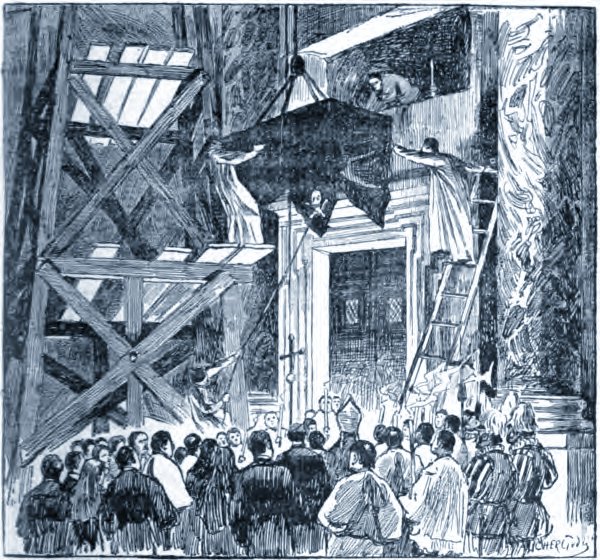SEDE VACANTE 1878
February 7, 1878—February 20, 1878
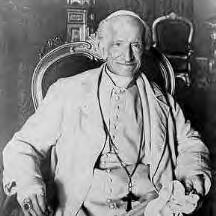
Gioacchino Card. Pecci (Pope Leo XIII)
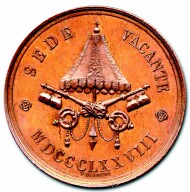 |
SEDE | VACANTE MDCCCLXXVIII |
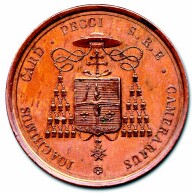 |
IOACHINUS CARD PECCI S . R . E . CAMERARIUS Arms of Gioacchino Card. Pecci, Camerlengo of the Holy Roman Church (1877-1878). Mazio 917. (by Francesco Bianchi) |
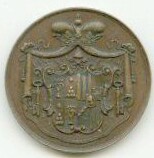 |
Arms of Prince Mario Chigi, surmounted by princely coronet and drapery, flanked by two keys as supporters. |
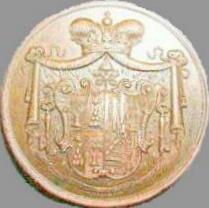 |
Engraver: G. Pasinati |
"L' origine de tant de médailles remonte à l'époque où le conclave se tenait toujours au palais du Vatican, et où l'on interdisait à tout le monde, pendant tout le temps de sa durée, l'entrée de la cité Léonine, c'est-à-dire du quartier appelé le Borgo. Alors tous ceux qui, soit pour leurs affaires, soit pour tout autre motif, devaient se rendre dans ce quartier du Borgo, étaient arretés en tête du pont Saint-Ange ou de tout autre pont communiquant avec le Vatican; on ne laissait passer que ceux qui étaient porteurs d'une médaille expressément frappée pendant la vacance du siége au nom de l'un des personnages nommés ci-dessus." X. Barbier de Montault, Le Conclave (Roma 1878) 19. |
No coins of the Sede Vacante were issued. Normally the Camerlengo, the Hereditary Marshal, the Majordomo as Governor of the Conclave, the Conservatori of Rome, the Governor of Rome, the Treasurer of the Holy Roman Church, and the Auditor General of the Apostolic Chamber had the right to issue medals. In this Conclave, only the Camerlengo and Hereditary Marshal issued medals (De Cesare Dal conclave 325-326).
GIOACCHINO VINCENZO CARDINAL PECCI (1810-1903), was born at Carpineto near Anagni, south of Rome. He was the son of Domenico Luigi Pecci (not of the Pecci of Siena) and Anna Prosperi (alleged to be a descendant of Cola di Rienzi). He studied at the Jesuit College in Viterbo (1818-1824) and at Rome,
at the Roman College and at the Academy of Noble Ecclesiastics (entered in 1832). He received a doctorate in canon and civil law from the University of Rome La Sapienza. He was ordained
priest in 1837 and made Governor of Benevento less than two months later (1838-1841), then Spoleto (June-July 1841),
and then Perugia (1841-1843). He joined the diplomatic service, as Nuncio to Bruxelles (1843-1846), and to facilitate that function was made Titular Archishop of Damietta.
He was recalled, however, on the demand of
King Leopold I, and was made Bishop of Perugia (1846-1878) in compensation for his embarassment. He was named a cardinal on December 19, 1853 by Pope Pius IX, and was given the titular Church of S. Crisogono
in Trastevere. On September 21, 1877, he was appointed Camerlengo, a post which he held until his election to the papacy on February 20, 1878. On the political problems involved in his appointment, see Lector, Le conclave 281-283.
The Dean of the Sacred College of Cardinals was Luigi Cardinal Amat (June 21, 1796-March 30, 1878), who was present at the conclave, but was seriously ill, in consideration of which he was granted a third conclavist.. He had been created Cardinal by Gregory XVI on May 19, 1837.
The Majordomo (Prefect of the Pontifical Household) and Governor of the Conclave was Msgr. Francesco Marinelli, OESA.
The Secretary of the Conclave was Msgr. Pietro Lasagni, the Secretary of the Consistorial Congregation and Secretary of the Sacred College of Cardinals.
The Marshal of the Conclave was Prince Mario Chigi (1832-1914), son of Prince Sigismondo Chigi della Rovere Albani, principe de Farnese (1798-1877) and Amalia Charlotte, princessa Barberini Colonna. His family held the post of Hereditary Marshal of the Holy Roman Church (His medal: Mazio #918; De Cesare, Il conclavo, p. 276, states that the medal was engraved by G. Pasinati, and issued in AV, AG, and AE. See also Lector, 363-364.).
The Papal Master of Ceremonies at the Conclave was Msgr. Pio Martinucci. He was assisted by Camilo Balestra, Giuseppe Romagnoli, Antonio Cataldi, Alessandro Tortoli, and Agostino Accoramboni.
Death of the Pope
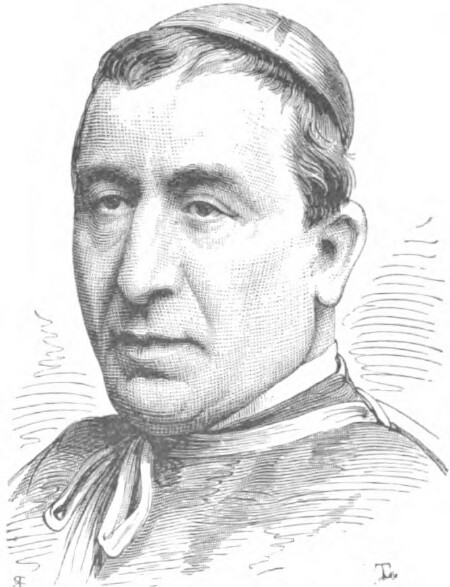
Pope Pius IX died on February 7, 1878, around 6:00 p.m., in the Vatican Palace (Lector, 146). At the bedside were thirty-eight cardinals, led by the Major Penitentiary, Cardinal Antonio Bilio [portrait at right] and the Camerlengo, Cardinal Gioacchino Pecci. The Chamberlain was in a delicate position politically and diplomatically: his duty was to act as conservator of the temporal property of the Holy See, nearly all of which had been seized by the new Kingdom of Italy. Virtually any move he might make could provoke serious reaction. Contrary to custom and the Constitution of Pope Clement XII (Lector, 192), the first General Congregation of the College of Cardinals took place on the next day rather than on the fourth day after the pope's death. It was contended that there were special circumstances, since Rome was under occupation, and there was a question as to whether the Conclave could be held there safely (Lector, 198-200). Despite proclamations from several Italian authorities, it was feared that the Vatican might be occupied by Italian troops. Pius IX had foreseen all of these difficulties, and had been making provision for some years. On August 23, 1871, he issued a bull, In hac sublimi, which confirmed the right of the cardinals to an unobstructed election, excluded any lay interference, and granted the curial cardinals the right to decide whether the conclave would be held in Rome or elsewhere (Ceccaroni, 85-98). This bull was confirmed in another bull on September 8, 1874, Licet per apostolicas (Ceccaroni, 98-105), and yet again in the bull Consulturi of October 10, 1877 (Ceccaroni, 105-120). On January 10, 1878, the Pope issued a series of directions, giving specific instructions in the most minute detail for the Interregnum and the Conclave (Ceccaroni, 121-129). Several cardinals were already in favor of moving the Conclave out of Rome, including Franzelin, Ledochowski and Manning. Thirty of the thirty-eight cardinals at their first meeting were in favor of moving the Conclave out of Rome (Spectator alter, 80-81). By the next meeting, the number in favor of moving the Conclave to Spain had been reduced to five, with thirty-two in favor of remaining in Rome. But after further Italian assurances were received (See De Cesare, Dal conclave, 161-178), and Cardinal Di Pietro, the Sub-Dean of the Sacred College, intervened in the debates, only five cardinals still wished to abandon Rome.
Funeral Ceremonies
The body of the pope was enbalmed on the evening of February 8, and his praecordia carried in a marble urn to the Old Crypt of Saint Peter's Basilica (to the right of the heavy pillar in the photo). The praecordia were customarily carried in a nocturnal procession to the Church of S. Vincenzo ed Anastasio at the Fontana di Trevi, the parish church of the Quirinale Palace. There they were placed in a special crypt along with the praecordia of numerous other popes since the seventeenth century [V. Forcella, Inscrizioni delle chiesa di Roma IX, p. 273, no. 553; p. 274, nos. 555 and 556; p. 275, nos. 559 and 562; p. 276, nos. 565 and 566; p. 278, nos. 571 and 572; p. 280, no. 577; p. 281, no. 581; p. 291]. This had been done on the occasion of the death of Pius IX's predecessor, Gregory XVI. On this occasion, however, with Rome in the hands of "the Enemy", the House of Savoy, and with the sentiments of the people of Rome strongly against the late Pope, who had ruled over them for a quarter of a century only with the military support of the French, it was not thought desirable to attempt to carry out the traditional rites. Therefore, the praecordia were placed in the crypt of the Vatican Basilica.
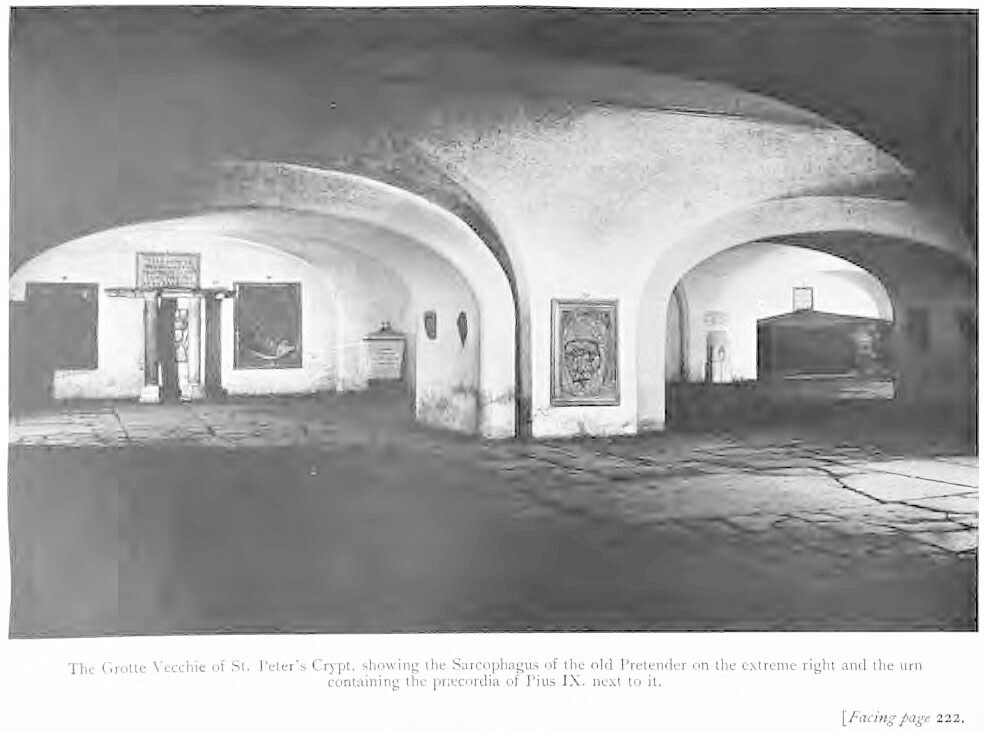
From: D. Sladen, The Secrets of the Vatican (Philadelphia 1907) 222
From February 9 to February 13, the body lay in state in St. Peter's. In the evening the coffin was entombed in a niche above the door to the chapel of the Choir (Lector, 170-176). It remained there until a permanent tomb was constructed in S. Lorenzo fuori le mure. On the occasion of the transfer of the body to S. Lorenzo, the popular disorders were such that the body was nearly seized and thrown into the Tiber.
Solemn masses for the repose of the soul of the late pontiff were held in the Sistine Chapel on the 15th, 16th, and 17th of February, at which the entire College of Cardinals were present. After the Mass on each day, the Cardinals received the diplomats accredited to the Holy See, each of whom expressed their condolences.
The Cardinals
The names of all the cardinals and their conclavists, as well as the principal attendants at the Conclave are given in: Leonis XIII Pontificis Maximi Acta Volumen I (Roma 1881) 26-34. Another list is provided by Gerardo Mullé de la Cerda, in his Apéndice Num. II., 161-170
- Luigi Amat di San Filippo e Sorso (aged 81), Suburbicarian Bishop of Ostia and Velletri , dean of the Sacred College of Cardinals. (died March 30, 1878)
- Camillo di Pietro (aged 72), Suburbicarian Bishop of Porto and Santa Rufina (died March 6, 1884).
- Carlo Sacconi (aged 69), Suburbicarian Bishop of Palestrina (died February 25, 1889).
- Filippo Maria Guidi, OP (aged 62), Suburbicarian Bishop of Frascati (died February 27, 1879).
- Luigi Maria Bilio, CRSP (aged 51), Suburbicarian Bishop of Sabina (died ) .
- Carlo Luigi Morichini (aged 72), Bishop of Albano (died April 26, 1879).
- Friedrich Johannes Jacob Celestin von Schwarzenberg (aged 68), Cardinal Priest of S. Agostino (died March 27, 1885) Prince-Archbishop of Prague. He had voted non placet on the 17th of July, 1870, on the schema on Papal Infallibility [Dollinger, Letters from the Council p. 778].
- Fabio Maria Asquini (aged 75), Cardinal Priest of S. Lorenzo in Lucina (died December 22, 1878)
- Domenico Carafa di Traetto (aged 72), S. Maria degli Angeli (died June 17, 1879) Archbishop of Benevento.
- François Auguste Ferdinand Donnet (aged 82), Cardinal Priest of S. Maria in Via (died December 22, 1882), Archbishop of Bordeaux
- Gioacchino Pecci (aged 67), Cardinal Priest of S. Crisogono (died July 20, 1903) Camerlengo of the Holy Roman Church, Bishop of Perugia
- Antonio Benedetto Antonucci (aged 79), Cardinal Priest of S. Martino ai Monti (died January 29, 1879). Archbishop-bishop of Ancona
- Anton Maria Panebianco, OFM Conv. (aged 69), Cardinal Priest of SS. XII Apostoli (died November 21, 1885) Major Penitentiary.
- Antonino de Luca (aged 72), Cardinal Priest of SS. Quattro Coronati (died December 28, 1883)
- Jean-Baptiste Pitra, OSB (aged 65), Cardinal Priest of S. Callisto (died February 9, 1889). Librarian and Archivist of the Holy Roman Church.
- Henri-Marie-Gaston de Boisnormand de Bonnechose (aged 77), Cardinal Priest of S. Clemente (died October 28, 1883). Archbishop of Rouen
- Gustav Adolf von Hohenlohe (aged 54), Cardinal Priest of S. Maria in Traspontina (died October 30, 1896) .
- Lucien-Louis-Joseph-Napoleon Bonaparte (aged 49), Cardinal Priest of S. Pudenziana (died November 19, 1895).
- Innocenzo Ferrieri (aged 67), Cardinal Priest of S. Cecilia (died January 13, 1887)
- Giuseppe Berardi (aged 67), Cardinal Priest of SS. Marcellino e Pietro (died April 6, 1878) .
- Juan Ignacio Moreno y Maisonave (aged 60), Cardinal Priest of S. Maria della Pace (died August 28, 1884). Archbishop of Toledo
- Raffaele Monaco La Valetta (aged 50), Cardinal Priest of S. Croce in Gerusalemme (died July 14, 1896). Vicar-General of Rome
- Ignacio do Nascimento Moraes Cardoso (aged 66), Cardinal Priest of SS. Nereo ed Achilleo, (died February 23, 1883). Patriarch of Lisbon
- René-François Régnier (aged 83), Cardinal Priest of Santissima Trinità al Monte Pincio (died January 3, 1881). Archbishop of Cambrai
- Flavio Chigi (67), Cardinal Priest of S. Maria del Popolo (died February 15, 1885). Archpriest of the Lateran Basilica .
- Alessandro Franchi (aged 58), Cardinal Priest of S. Maria in Trastevere (died July 31, 1878) .
- Joseph-Hippolyte Guibert, OMI (aged 75), Cardinal Priest of S. Giovanni a Porta Latina (died July 8, 1886). Archbishop of Paris
- Luigi Oreglia di Santo Stefano (aged 49), Cardinal Priest of S. Anastasia (died December 7, 1913).
- János Simor (aged 64), Cardinal Priest of S. Bartolomeo all’Isola (died January 23, 1891). Archbishop of Esztergom
- Tommaso Maria Martinelli, OESA (aged 51), Cardinal Priest of S. Prisca (died March 30, 1888)..
- Ruggero Luigi Emidio Antici Mattei (aged 66), Cardinal Priest of S. Lorenzo in Panisperna (died April 21, 1883).
- Pietro Giannelli (aged 70), Cardinal Priest of S. Agnese fuori le mura (died November 5, 1881).
- Mieczyslaw Halka Ledóchowski (aged 55), Cardinal Priest of S. Maria in Ara Coeli (died July 22, 1907) Archbishop of Gnesen and Posen
- Henry Edward Manning (aged 69), Cardinal Priest of Ss. Andrea e Gregorio al Monte Celio (died January 14, 1892). Archbishop of Westminster
- Victor-Auguste-Isidor Deschamps, CSSR (aged 67), Cardinal Priest of S. Bernardo alle Terme (died September 29, 1883). Archbishop of Mechlin
- Giovanni Simeoni (aged 61), Cardinal Priest of S. Pietro in Vincoli (died January 14, 1892). Secretary of State of Pius IX (1876-1878).
- Domenico Bartolini (aged 64), Cardinal Priest of S. Marco (died October 2, 1887).
- Bartolomeo D'Avanzo (aged 66), Cardinal Priest of S. Susanna (died October 20, 1884). Bishop of Calvi e Teano .
- Johannes Baptist Franzelin, SJ (aged 61), Cardinal Priest of SS. Bonifacio ed Alessio (died December 11, 1886).
- Francisco de Paula Benavides y Navarrete (aged 67), Cardinal Priest of S. Tommaso in Parione (died March 30, 1895). Patriarch of the West Indies
- Francesco Saverio Apuzzo (aged 70), Cardinal Priest of S. Onofrio (died July 30, 1880) .Archbishop of Capua
- Manuel García y Gil, OP (aged 75), Cardinal Priest of S. Stefano al Monte Celio (died April 28, 1881). Archbishop of Saragossa
- Edward Henry Howard (aged 69), Cardinal Priest of SS. Giovanni e Paolo (died September 16, 1892).
- Miguel Payá y Rico (aged 66), Cardinal Priest of SS. Quirico e Giulitta (died December 24, 1891), Archbishop of Santiago de Compostela
- Louis-Marie-Joseph-Eusebe Caverot (aged 71), Cardinal Priest of S. Silvestro in Capite (died January 23, 1887), Archbishop of Lyon
- Luigi Di Canossa (aged 68), Cardinal Priest of S. Marcello (died March 12, 1900), Bishop of Verona
- Luigi Serafini (aged 69), Cardinal Priest of S. Girolamo dei Schiavoni/Croati (died February 1, 1894), Bishop of Viterbo
- Josip Mihalovic (aged 64), Cardinal Priest of S. Pancrazio (died February 19, 1891), Archbishop of Zagreb
- Johann Rudolf Kutschker (aged 66), Cardinal Priest of S. Eusebio (died January 27, 1881), Archbishop of Vienna
- Lucido Maria Parocchi (aged 44), [born in Mantua on August 13, 1833]. Cardinal Priest of S. Sisto (June 22, 1877). Did his theological training at the Gregorian University, Rome. Doctor of Theology. Bishop of Pavia (1875). Archbishop of Bologna (March 1877). In 1899 he was named Vice-Chancellor S.R.E. He died January 15, 1903, of a heart disease, during a bout of influenza [Civilta Cattilica series 18 volume 9, Quad. 1263 (Roma: 9 Feb. 1903), 363)].
- Vincenzo Moretti (aged 62), Cardinal Priest of S. Sabina (died October 6, 1881), Archbishop of Ravenna
- Prospero Caterini (aged 82), Cardinal Deacon of S. Maria in Via Lata (died October 28, 1881) Cardinal Protodeacon
- Teodolfo Mertel (aged 72), Cardinal Deacon of S. Eustachio (died July 11, 1899) .
- Domenico Consolini (aged 71), Cardinal Deacon of S. Maria in Domnica (died December 20, 1884).
- Edoardo Borromeo (aged 55), Cardinal Deacon of SS. Vito, Modesto e Crescenzia (died November 30, 1881).
- Lorenzo Ilarione Randi (aged 59), Cardinal Deacon of Cardinal-Deacon of S. Maria in Cosmedin (died December 20, 1887).
- Bartolomeo Pacca (aged 60), Cardinal Deacon of S. Maria in Portico (died October 14, 1880).
- Lorenzo Nina (aged 65), Cardinal Deacon of S. Angelo in Pescheria (died July 25, 1885).
- Enea Sbarretti (aged 70), Cardinal Deacon of S. Maria ad Martyres (died May 1, 1884).
- Frédéric de Falloux de Coudray (aged 62), Cardinal-Deacon of S. Agata alla Suburra (died June 22, 1884).
- Antonio Pellegrini (aged 65), Cardinal-Deacon of S. Maria in Aquiro (died November 2, 1887).
- Godefroy Brossais-Saint-Marc (aged 76), Cardinal Priest of S. Maria della Vittoria (died February 26, 1878). archbishop of Rennes, France,
- Paul Cullen (aged 74), Cardinal Priest of S. Pietro in Montorio (died October 24, 1878) Archbishop of Dublin [arrived after the election]
- John McCloskey (aged 67), Cardinal Priest of S. Maria sopra Minerva (died October 10, 1885). Archbishop of New York [arrived after the election]
Early Maneuvers
On February 11, Count Andrassy informed the Austrian representative at the Vatican, Graf Paar, that the Emperor was not favorable to the candidacies of either Cardinal Ledochowski (an exile in Rome because of the Prussian Külturkampf) or Cardinal Joannes-Baptist Franzelin, SJ (Engel-Janosi, 210-211). On the evening of the 15th, a private meeting took place in the rooms of Cardinal Bartolini, which included Cardinals Manning, Franchi, Bilio, Monaco and Nina. The name of Cardinal Pecci was proposed as a candidate by Cardinal Bartolini, and it was unanimously agreed by those present that he was their first choice. They also agreed, after some discussion of other possibilities as a second choice, including Manning himself, that the next pope had to be an Italian. Cardinal Manning agreed to speak with the non-Italians in favor of Pecci, aided by Cardinal Howard. (Life of Cardinal Manning, 550-551).
Balloting
The Conclave of 1878 was a short one. It began on the evening of February 18, with sixty-one cardinals in attendance. Earlier that day the Mass of the Holy Spirit had been sung in the Pauline Chapel of the Vatican by Cardinal Schwarzenberg (Archbishop of Vienna). In the evening, Cardinal Gioacchino Pecci, the Camerlengo, presided over the closing of the gates of the Conclave, enclosing some 250 persons. In addition to support for Cardinal Pecci, Cardinal Chigi and Cardinal Martinelli were also being touted. On the 19th a ballot was taken at noon, giving Cardinal Pecci 23 votes, but it was apparently voided because of a violation in the rules of filling out individual ballots; two ballots had become conjoined by the sealing wax (Lector, 631-632). Keller states (p. 246) that the problem was caused because "one of the cardinals had, contrary to the regulation, affixed to his paper a seal which bore the mark of the dignity of a cardinal."
| Bilio | 7 |
| Pecci | 23 |
| Monaco | 4 |
| 4 or 5 Others | 27 |
Spectator alter (p. 86) has a different count:
| Bilio | 7 |
| Pecci | 19 |
| Franchi | 5 |
| De Luca | 5 |
On the morning of the 19th Cardinal Donnet (Archbishop of Bordeaux) entered conclave.
Election
A second ballot gave Cardinal Pecci 38 out of the 61 votes cast—a majority, but not the 2/3 needed for election. After the second ballot was completed, the Patriarch of Lisbon, Cardinal Moraes Cardoso, arrived and was duly admitted and sworn. In this interval (Lector, 386), the opponents of Pecci joined together and agreed to support Cardinal Franchi, but on February 20, on the third ballot, Cardinal Pecci received 44 out of 62 votes, and was canonically elected. De Cesare (Dal conclave p. 306) gives the details of the voting:
| Bilio | 5 |
| Schwarzenberg | 1 |
| Pecci | 44 |
| Panebianco | 3 |
| Ferreri | 1 |
| Monaco | 2 |
| Martinelli | 2 |
| Simeoni | 2 |
| Canossa | 1 |
Those said to have been most hostile to Cardinal Pecci were Cardinals Oreglia, Giannelli, Chigi, Randi, Sacconi, Monaco, Amat, and Franzelein. No veto was presented during the Conclave, due to the swiftness of the action of the electors, though a number of Powers, with the active instigation of Bismarck, had been laying plans to see that the right sort of pope was elected (Lector, 504-510). The canonical election was proclaimed from the windows of the loggia above the narthex of St. Peter's Basilica, to those gathered inside the basilica. The Italian government had expressed alarm at the possibility of violent demonstrations if the proclamation were to be made in the normal way, from the outward-facing windows of the loggia (See De Cesare, Dal conclave, 309-320).
Cardinal Pecci took the name Leo XIII (died July 20, 1903), and was crowned in the Sistine Chapel (March 3), since his own diocese was anathema to him, after its incorporation into the Kingdom of Italy in 1870 (See De Cesare, Dal conclave, 335-344). He never took possession of the Lateran Basilica, never having left the Vatican in the twenty-three years of his pontificate.
Bibliography
See: Raffaele De Cesare, Il conclavo di Leone XIII, con aggiunte e nuovi documenti, e il futuro conclavo (Città di Castello: S. Lapi 1888), 231-262. De Cesare, Dal conclave di Leone XIII al ultimo consistorio (studii, ricordi, e documenti) (Città del Castello 1899); a complete list of participants is given on pp. 381-287. J. F. Talbot, Pope Leo XIII: His Life and Letters (Boston 1886) 48-52. Lucius Lector [pseudonym of Joseph Guthlin], Le conclave (Paris 1894), passim. [Spectator Alter], Die Krisis im Papsttum (Berlin 1904) 77-88. On the physical arrangements for the Conclave at the Vatican in 1878, see Lector, 322-325 and Plan IV. Henry Cardinal Manning's notes, made at the time of the Conclave, survive; see: E. S. Purcell, Life of Cardinal Manning (New York: Macmillan 1896) Volume II, 547-552.
Friedrich Engel-Janosi, Osterreich und der Vatikan 1846-1919 Erster Band (Graz-Wien-Koln 1958) 200-214. Friedrich Engel-Janosi, "Austria and the Conclave of 1878," Catholic Historical Review (July 1953) 142-166. Gerardo Mullé de la Cerda, Reseña histórica del último cónclave, y biografía de N. S. P. Leon XIII (Madrid 1878).
Joseph Keller, The Life and Acts of Pope Leo XIII (New York 1882), 243-264. Julien de Narfon, Pope Leo XIII: His Life and Work (London 1899) 115-128. Francesco di Domenico, Vita e Pontificato di Leone XIII seconda edizione (Napoli 1903) 45-47.
For the lengthy ceremonies involved in admitting the Patriarch of Lisbon to the Conclave, see Agostino Ceccaroni, Il conclavo (Torino-Roma 1901) pp. 41-43 (quoting from L' Osservatore Romano, February 21, 1878). On the office of Governor of the Conclave, see Lector, pp. 357-362.
